Principali progetti di ricerca in corso
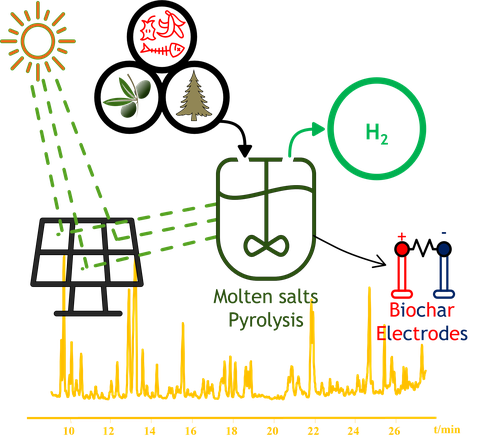
Co-production of green hydrogen and carbon materials with high electrochemical performance through molten-salt assisted pyrolysis of biomass
Partners: University of Bologna (UNIBO, lead D.Fabbri), University of Perugia (UNIPG, lead F.Fantozzi), Zhejiang University (ZJU, lead S.R.Wang), Huazhong University of Science and Technology (HUST, lead H.Y.Yang)
Objectives: -Ultrastructure characterization and pyrolysis mechanism of biomass -Reaction mechanism of molten-salt assisted pyrolysis of biomass through solar heating -Catalytic reforming of light fraction for hydrogen production -Modification of biochar/carbon for electrode materials with advanced performance -Optimization and evaluation of GREENHYDCM
UNIBO activities: 1- Select different biomass species (rice straw, cotton stalk, wood chip, digestate, etc.) for ultrastructure characterization and self-bonding models; 2- Analyze pyrolysis products and identify the key intermediates using conventional and new chromatographic, mass spectrometric, spectroscopic methods and explore the pyrolysis mechanism; 3- Directional modification of biochar/carbon to expand pore size and incorporate surface active sites; 4- Optimize and integrate the co-generation system, build biomass pyrolysis co-generation technology; 5- Clarify the energy consumption, carbon emissions, economic benefits and social benefits of the system.
UNIBO Team: Daniele Fabbri, Cristian Torri, Martina Zangheri, Alessandro Rombolà, Elahe Ahmadi, Andrea Facchin
Science and technology cooperation Italy- R.P.China MAECI-NFSC (Ministry of Foreign Affairs and International Cooperation of the Republic of Italy and the National Natural Science Foundation of China). Joint Research Projects. [2023-2025]
Preliminary website: https://chemistry.unibo.it/en/research/research-projects/other-projects/greenhydcm

gas power plant and industrial processes is recognised to be one of the most effective measures to the European Union’s commitment to reach climate neutrality by 2050 and mitigate against global warming staying within 1.5 oC of pre-industrial levels during the remainder of the 21st century. Post-combustion CO2 capture (PCC) will play a key role since it can be retrofitted and adapted to existing power plant and industrial processes. Amine scrubbing is the most mature technology having been adapted from separating CO2 from natural gas. However, amine scrubbing has limitations, including high energy demand for regenerating the solvent and environmental problems such as volatile amine loss and reactor corrosion, which are not completely solved by using mixed amines rather than monoethanolamine (MEA). These factors result in relatively high capture costs and this has catalysed the development of alternative or second-generation technologies. Although showing considerable promise as such a technology, solid adsorbents are at a relatively early stage of development and have not been investigated extensively at pilot-scale and demonstration scale.
Silica-polyethylenimine (PEI) is a leading candidate amongst strongly basic adsorbents for both PCC and direct air capture. The key drivers to the successful implementation of silica-PEI in solid adsorbent looping technology (SALT) using fluidised-beds for both adsorption and desorption are (i) maximising the working dynamic CO2 adsorption capacity at high capture efficiencies and (ii) keeping the adsorbent replacement costs below ca. 10 € per tonne of CO2 captured, which will be comparable to those for MEA in amine scrubbing. Initial analysis indicates that lifetimes approaching 12 months will be required, assuming conservative performance parameters in terms of dynamic adsorption capacity and heat recovery. Therefore, the overall aim of the proposed two-year research programme is to demonstrate that such lifetimes can be achieved by optimising silica-PEI composition and SALT can achieve lower capture costs through maximising the dynamic CO2 adsorption capacity in continuous operation which will reduce the regeneration energy to approaching 2.0 GJ/tonne CO2. Further, the scope to reduce costs by recovering the silica from spent adsorbent and converting the PEI to chemical feedstocks will be explored. The findings will provide a basis of comparison with other technologies, including advanced amines and oxyfuel combustion where the focus will be on the cement industry.
The performance of silica-PEI will be optimised in terms of the working dynamic CO2 adsorption capacity and the physical and chemical stability with respect to flue gases representing PCC from power plants and industrial processes, such as cement and lime production, in pilot-scale facilities using 5-20 kg of adsorbent. PEI will be stabilised through alkoxylation and the optimum level will be established so as not to vastly reduce the CO2 adsorption capacity. The PEI will be further stabilised with an antioxidant and a chelating agent. Further, surfactants will improve the CO2 adsorption kinetics and through this, the dynamic working capacity. Regeneration strategies will be devised so that that the silica can be recycled and, when PEI degrades, it can be pyrolyzed to yield platform chemicals that potentially have high market value. Comprehensive techno-economic analysis and life cycle analysis (LCA) of SALT including the material replacement costs will be conducted, together with an initial high-level design of a demonstration facility operating at 10 MWe equivalent for a cement/lime plant. Achieving the results anticipated will enable SALT to be bench marked in relation to amine scrubbing and oxyfuel combustion for both natural gas CCGT power plants and cement/lime production and provide the platform for taking silica-PEI SALT to full demonstrations at TRL 6-8.
The Consortium brings together PQ Corporation and BASF who are global manufacturers of silicas and PEI, respectively and with the University of Nottingham will use their materials expertise to optimise the composition of silica-PEI. The University of Ulster, CERTH and CEMEX have extensive experience in techno-economic analysis (TEA) and life cycle assessment (LCA), the involvement of CEMEX enabling us to address in detail the application of SALT to cement plants. The University of Bologna, CERTH and the University of Nottingham have extensive expertise in pyrolysis for recycling the silica and converting the spent PEI to potentially valuable chemicals.
For more info, visit the official website: https://absaltresearch.com/
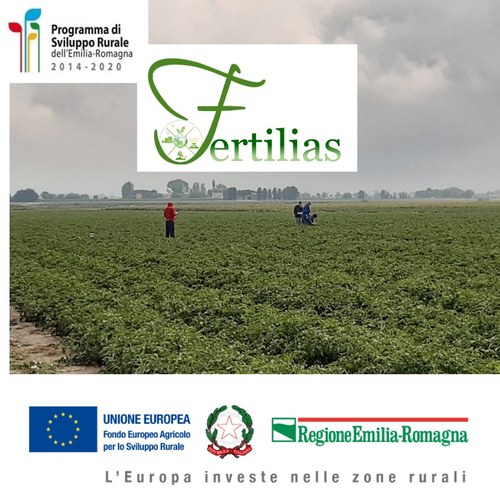
FERTILIAS «Strategie green di biorisanamento dei suoli per una migliore gestione idrica, dei fertilizzanti e dei pesticidi» 01/02/2020 -31/03/2022
Partners: CINSA, UNIBO, AGRIFORM, Az.Agraria sperimentale Stuard, Società Agricole: Contarini, Ganazzoli e Trombini.
Il progetto propone una metodologia eco-sostenibile che combina tecnologie innovative a pratiche agro-industriali e agronomiche: include interventi di precision agriculture, substrati organici e inorganici innovativi per l’agricoltura ma anche per vivaismo e bio-risanamento, riduzione dell’apporto di fertilizzanti/ammendanti e fitofarmaci, attività specifiche biostimolanti, bio-antiparassitarie e di bio-risanamento di suoli.
Attività UNIBO: studiare l’influenza dei substrati sulla dinamica e speciazione del carbonio e dell’azoto attraverso analisi chimica dei suoli ed esperimenti di rilascio su campioni di suolo/substrati rappresentativi.
Team UNIBO: Daniele Fabbri (ccordinatore scientifico); Ivano Vassura; Marco Montalti; Cristian Torri; Beatrice Rizzi.
Progetto finanziato nell’ambito della politica di sviluppo rurale dell'UE finanziata dal Fondo Europeo Agricolo per lo Sviluppo Rurale FEASRi https://ec.europa.eu/agriculture/rural-development-2014-2020_it
Per maggiori informazioni visitare il sito web: https://www.gofertilias.it/PSR%202014-2020
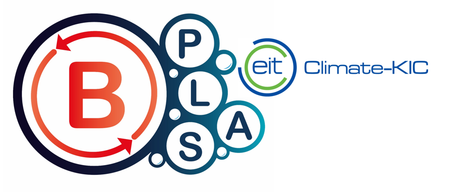
Nearly 40% of chemical energy of food ends up in wastes or in wastewaters. Wastewater organics are concentrated through aerobic wastewater treatment plant (WWT) yielding biosolids with an overall European production equal to 20 Mton/y in the EU area (Eurostat, 2017). As wastewater treatment improved, sludge production increased. Regulations moved the practice from open disposal on land and oceans, to bans on ocean dumping, and beneficial land-based reuse. WWT sludge is actually disposed through land application (56%), incineration (27%) or landfilling (17%), with greenhouse gas emissions, potential biohazard and variable disposal cost between 5 and 120 € per wet ton. Today more than ever, there is the need of reducing sludge and its chemical and energy content exploitation, converting sludge from a cost to a benefit.
Existing commercial solutions cannot treat all types of sludge and suffers from relative high fixed costs that are poorly mitigated by a relatively low value of the final product. On the other hand, there is a large demand for renewable biodegradable materials (e.g. bioplastics) to reduce fossil fuel consumption and plastic waste pollution.
The B‐PLAS project aims to realize fully automated plant that allows to convert food waste, waste sludge and other organic residues into Polyhydroxyalkanoates (PHA).
PHA is a bio‐based and bio‐degradable plastic, suitable for packaging, disposable items, medical application and 3D printing.
Currently the cheapest bioplastic spool costs more than 30 € per kg, bioplastic pellets more than 6 € per kg, food and other organic wastes are readily available and free.
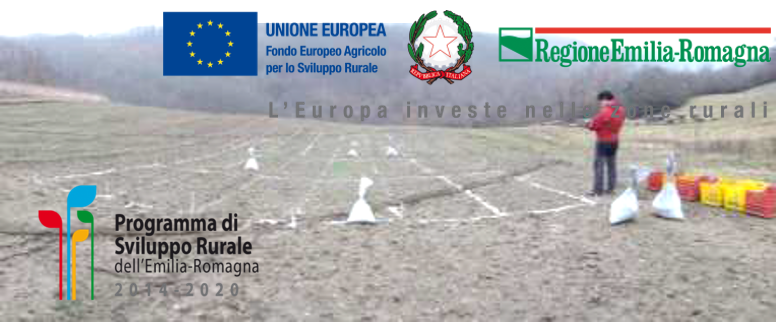
Biochar: l’Acchiappa Carbonio. Progetto finanziato dalla Misura 16.1 del Piano di Sviluppo Rurale dell’Emilia Romagna 2014-2020. DURATA: dall’1 aprile 2016 al 31 marzo 2019
L’obiettivo principale del progetto è l’identificazione di un processo in grado diintervenire sul ciclo del carbonioarrestando la fase di degradazione dei residui legnosi con la loro carbonificazione, convertendoli in prodotti durevoli. Obiettivo secondario èincrementare il contenuto di microrganismi e sostanza organica(per un incremento di carbonio organico nel suolo) e un conseguente incremento produttivo (con ulteriore incremento di sequestro del carbonio). I risultati attesi sono finalizzati all’identificazione di un piano di gestione innovativo degli scarti delle aziende agricole, in grado di incrementare la quantità di carbonio stoccato nel suolo e nella biomassa vegetativa, al fine di potere realizzare piani per di sequestro del carbonio.
Attività (azione 5E):
http://www.stuard.it/il-progetto-lacchiappa-carbonio/
Progetto finanziato nell’ambito della politica di sviluppo rurale dell'UE finanziata dal Fondo Europeo Agricolo per lo Sviluppo Rurale FEASRi https://ec.europa.eu/agriculture/rural-development-2014-2020_it
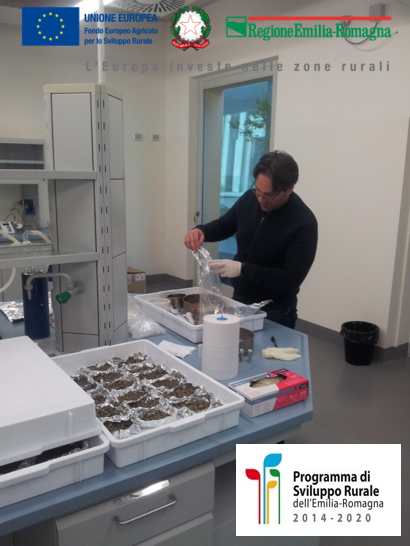
RIFASA: Uso del Biochar come filtro biologico per la depurazione delle acque: l’ammendante che depura l’ambiente.Progetto finanziato dalla Misura 16.1 del Piano di Sviluppo Rurale 2014-2020 della Regione Emilia-Romagna. DURATA: dall’1 aprile 2016 al 31 marzo 2019.
Il progetto propone lo studio di una tecnica agronomica innovativa per: aumentare l’efficacia depurativa delle fasce tampone, con l’utilizzo delbiocharsullefasce tamponee conl’estensione alle aree agricole limitrofe; carbonizzazione della biomassa sfalciata dagli argini limitrofi e dalle fasce tampone conproduzione dibiochare cogenerazione termica ed elettrica; incremento della sostanza organica e di conseguenza la biomassa microbica attiva; incremento dell’adsorbimento e della biodegradazione degli erbicidi; L’efficienza del Biochar verrà testata inzone vulnerabili ai nitrati(ZVN), con colture convenzionali, nell’ambito di una rotazione in pieno campo, presso i terreni agricoli limitrofi alle fasce tampone, con l’obiettivo di incrementare l’azione di rimozione degli agenti inquinanti.
Attività (azione 5):
http://www.stuard.it/progetto-rifasa/
Progetto finanziato nell’ambito della politica di sviluppo rurale dell'UE finanziata dal Fondo Europeo Agricolo per lo Sviluppo Rurale FEASRi https://ec.europa.eu/agriculture/rural-development-2014-2020_it

GoBioM- Ottimizzazione tecnologica della filiera biometano. Bando POR FESR Emilia-Romagna, Progetti di ricerca industriale strategica 2014-2020. DURATA: dal 1 aprile 2016 al 31 marzo 2018.
GoBioM si propone l’ottimizzazione tecnologica della filiera regionale/nazionale del biometano, con il superamento delle attuali principali criticità. La nostra unità di ricerca si occupa degli aspetti riguardanti lo sviluppo di protocolli analitici per la determinazione di composti chiave nel processo di digestione anaerobica e di contaminanti nel biogas e biometano. in particolare Acidi grassi volatili e metilsilossani volatili.
ACIDI GRASSI VOLATILI: sono composti intermedi derivanti da processi biochimici di degradazione della materia organica. Nella digestione anaerobica la concentrazione e la diversa tipologia di AGV presenti nel digestato possono fornire informazioni fondamentali sull’andamento del processo che porta alla produzione di biogas.
METILSILOSSANI VOLATILI: La presenza di VMS può inficiare il processo di produzione di energia da biometano. Infatti, l’ossidazione di questi contaminanti organici in combustione, produce silice microcristallina che depositandosi nei motori o in altre parti dell’impianto, causa problemi quali il blocco di parti meccaniche e l’inibizione dello scambio termico, che riducono l’efficienza globale del processo.
Informazioni nel sito del progetto: http://gobiom.crpa.it/nqcontent.cfm?a_id=13925&tt=t_bt_app1_www

Sviluppo di protocolli per l'analisi quantitativa di microplastiche in mare e in ambienti naturali